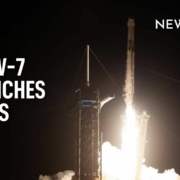Crew-7 launches to ISS
Crew-7 successfully launches to the International Space Station, from Launch Complex 39A at NASA’s Kennedy Space Center in Florida, on SpaceX’s Endurance Dragon spacecraft, powered by a Falcon 9 rocket. The crew includes: NASA astronaut Jasmin Moghbeli, European Space Agency (ESA) astronaut Andreas Mogensen, Japan Aerospace Exploration Agency (JAXA) astronaut Satoshi Furukawa, and Konstantin Borisov of Russia’s space agency. Over 200 science experiments and technology demonstrations will take place during Crew-7’s mission of approximately six months in space. Experiments will include the collection of microbial samples from the exterior of the space station, the first study of human response to different spaceflight durations, and an investigation of the physiological aspects of astronauts’ sleep. NASA Administrator Bill Nelson:
Crew-7 is a shining example of the power of both American ingenuity and what we can accomplish when we work together. Aboard station, the crew will conduct more than 200 science experiments and technology demonstrations to prepare for missions to the Moon, Mars, and beyond, all while benefitting humanity on Earth. By partnering with countries around the world, NASA is engaging the best scientific minds to enable our bold missions, and it’s clear that we can do more – and we can learn more – when we work together.
Axiom Mission 2 launches successfully
Axiom Space’s Axiom Mission 2 (Ax-2) to the International Space Station launches successfully from Launch Complex 39A (LC-39A) at NASA’s Kennedy Space Center in Florida.
The Dragon spacecraft used previously flew Crew-4 to and from the space station. Following stage separation, Falcon 9’s first stage lands on Landing Zone 1 (LZ-1) at Cape Canaveral Space Force Station, the first time a booster has been reused on a human spaceflight mission.
During their time on the orbiting laboratory, the crew will conduct over 20 science and technology experiments in areas such as human physiology, physical sciences, and STEAM to ‘help expand knowledge to benefit life on Earth in areas such as healthcare, materials, technology development, and enable industrial advances’.

